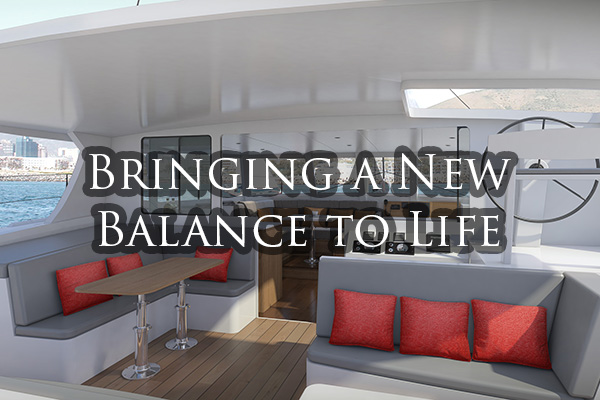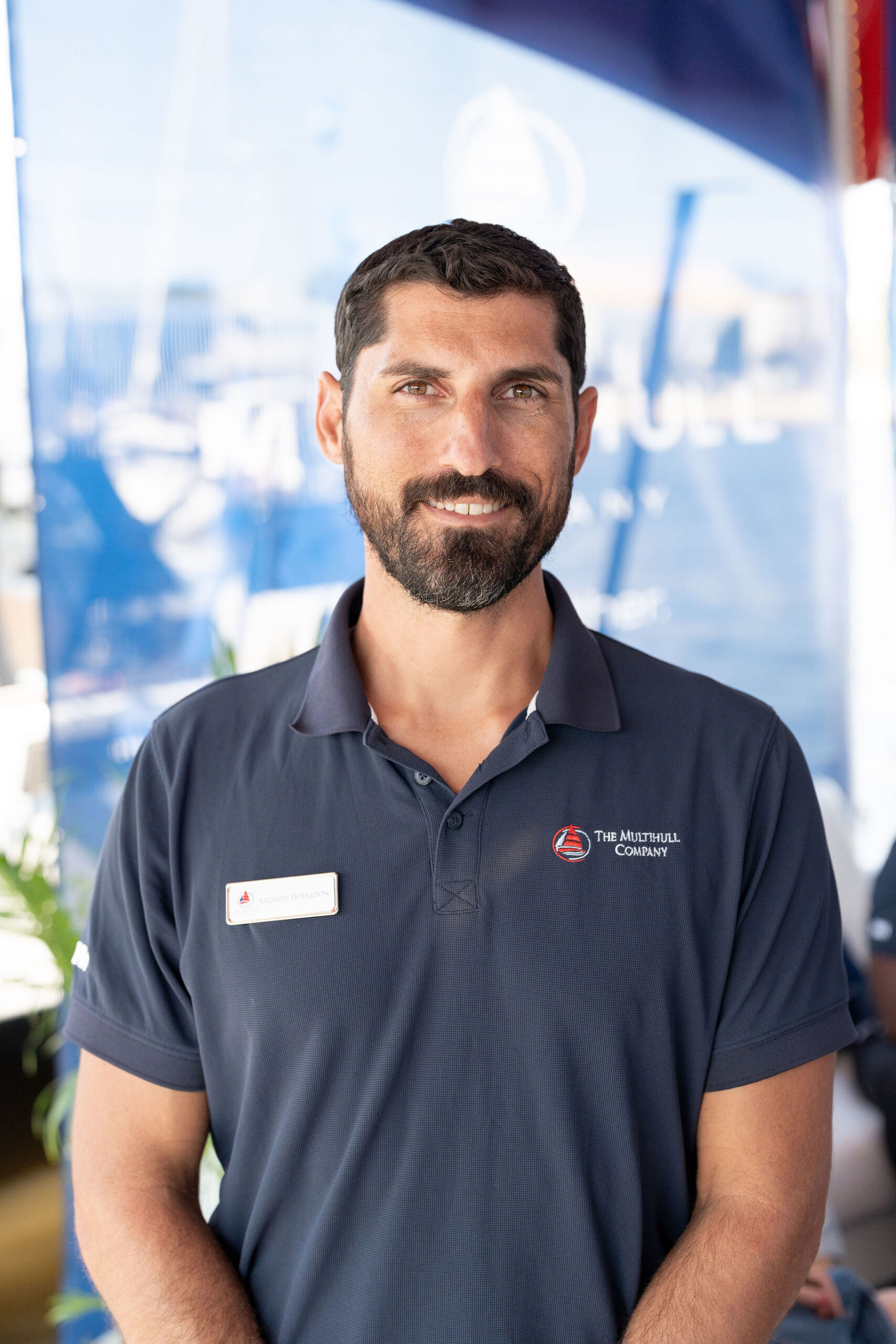Story by Andrew Hodgdon / May 15, 2020

What’s really involved in designing, engineering, tooling and building a new catamaran?
In early 2019, co-designers of the Balance 526 Phil Berman and Anton du Toit, were discussing the best way to build on the success of our award-winning catamaran. Due to my growing role at Balance Catamarans, I was fortunate enough to be brought into the brainstorming process and excited to share my insights from the past decade as a professional multihull captain. We started the conversation based on a trend that we had noticed in the feedback from many of our customers; they loved the design and build quality of Balance Catamarans but wanted a smaller option at a lower price point. We were eager to enter this segment of the market but needed to be cautious.
It should first be mentioned that no company will go through the process of creating a new catamaran model unless they are quite confident it will sell and have a strong market. Creating a new design, engineering it, and building the tooling is very costly. For that reason, many builders use the same tooling for a decade a more; simply making slight revisions to it after a few years in order to call it something new. I am amazed, as a yacht broker, how many one or two decade old designs are still being marketed and sold, often as brand new models. This is due entirely to the high cost of designing and tooling up a new boat. The good news for Balance was that we had very high demand for our 526 and 482. We knew our concepts and designs were well vetted and therefore felt confident the market would respond favorably to an entirely new 44ft model that shared the DNA of her very popular larger sisters.

It was imperative that we capture the same soul of the 526 and 482, only this time in a more compact package. The resulting concept was christened the Balance 442. The objective of the 442 was to create another fully modern, daggerboard equipped, world voyaging catamaran. It must also be truly livable for a couple or family to sail anywhere in the world, along with the expected equipment they would need to carry. The task was made easier because the boat was a refinement and scaled down version of the 526 – a tested design, with tested features.
We knew several of those features absolutely must be transferred from our flagship model over to the new 442 design. We had to include the innovative VersaHelm, we wanted to maintain the 6’8” headroom throughout the interior, and the design had to share the same balance of livability and performance that is our namesake. Meeting at the office of Du Toit Yacht Design in Cape Town, we began the laborious process of bringing a new Balance model to life.
The process began with an overall design brief. Phil, Anton and I wanted to sustain a real performance orientation in the new 442 without sacrificing her livability and payload capacity. We had to decide on the basic dimensions of the new boat and the list of necessary equipment she would need to have aboard. All liveaboard catamarans need much of the same equipment – watermakers, solar panels, two engines, refrigerators, freezer, air conditioning, etc. The smaller you go in size, the more challenging it is to equip a catamaran properly and keep her light enough and narrow enough to achieve that ideal balance. Base on those parameters, we then determined the materials we would use for her construction. We also had to consider the size and layout of her sail plan and match it to her projected displacement to achieve our performance goals.
We accelerated the design process by taking the specifics of the Balance 482 and simply shrinking them on a computer aided design program (CAD) to see where we would have to alter the 442. Anton then began the brand-new design by drawing the hull and cabin top of the vessel using the measurements that we had already agreed upon. Once we had a basic drawing, Phil and I gave our input about possible adjustments. Let’s give the bows a slightly sharper rake. I would prefer a rounded curve to the hardtop bimini. Make sure the davits aren’t pushed back too far. Eventually, spars and sails were added to the drawing. The trampoline and longeron dimensions became clear. We decided on the perfect size and outline for the sugar scoops. Slowly but surely, we started to see the new vessel taking shape on the screen.

Next, we moved the design focus to the interior. We played around with different placements of cabinetry, lockers and heads striving to find the best fit for all the necessary equipment. Tables moved from one side of the saloon to the other. Companionway stairs shifted fore and aft to find the best placement in relation to the daggerboard trunks. It became a game to see who could come up with the best idea for saving a few inches here or an extra centimeter there. Believe it or not, we actually got out a tape measure. We rearranged Anton’s office furniture so that we could simulate the space in a hallway or through a doorway. We stood on a chair to determine the height of a shelf or locker. We stacked books to see the clearance of a step. We had to have a clear understanding of how people would live and move in these spaces, using every bit of space to the best application. Always with the knowledge that Balance owners need to be comfortable in these spaces both at sea and at anchor. No detail could be overlooked or disregarded.
A great design is the culmination of thousands of small decisions and subtleties that most people miss. It is always about attention to the smallest things which, if gotten right, add up to a superb finished product. Can you sleep on her? Lounge on her? Is there good visibility from the helm – up or down? Is she managed easily under power or sail? Does she have enough cabinetry for long term storage? Does she have enough payload to carry equipment – tenders, kayaks, etc? Does she have enough headroom to avoid turning tall people away? Will she perform upwind? Will she ride over the seas or pound hard into them? Every choice is a decision that is a balancing act between form and function. Always striving to design a catamaran that is a marriage of beauty, functionality, and speed.
Once we were all happy with the overall design, we handed the project to Anton’s amazing design team to finalize. They scoured the layout looking for imperfections. Will this door open all the way? Will this plumbing be obstructed? Can this angle be improved? They put in hundreds of hours staring at every minute detail on the screen. Finally, the revised drawings were sent to the builder, Mark Delany at Balance Catamarans Cape Town, who has the daunting job of taking the design and turning it into reality. This inevitably leads to another round of revisions and adjustments as Mark dealt with the reality of taking a drawing and bringing it to life. Not only did we have to design the boat well, but we had to design the boat to go together well. So it went, with all parties to the design process working together to make a great catamaran. It is a collective belief at Balance that a total team approach to the design and build process improves our products. Disagreement, push back, and collective head scratching from as many knowledgeable parties as possible inevitably yields the best results.

It brings me great joy to play just one small part in the development of such amazing products. I am only one person in a process that will eventually involve over two hundred others, who dedicate their professional lives to building incredible catamarans. We are all very eager to see the new Balance 442 come to life over the next few months. Moving from a simple design on a computer screen to a floating work of art, carrying its new owners across oceans and creating memories they will cherish for a lifetime.

Was a pleasure working with Andrew Hodgdon as buyers agent for our recent multihull purchase. Very knowledgeable of this space and for sure my first call buying or selling a yacht.
The multihull company has been great to work with. They were very helpful in every stage of our purchase from instill showings to purchase. Karl Reed, Andrew Hodgon and Andrew Holland were great sources of information and helped us find our dream Catamaran. Thank you Multihull!
Sold my L42 here with the excellent help and support of TMCs Croatia sales manager “Zee”. Despite my boat docked on the dry in Montenegro, in winter and in a challenging market, TMC and Zee managed to get her sold, managing the entire process from taking pictures and video’s, putting her out there on the web, prepping her and managing all for inspections….down to the final hand-over documents and managing the escrow payments when all boxes were ticked! Very professional, very helpful (Zee went above and beyond to make sure he delivers excellent service), responsive and successful. Thanks TMC!
We purchased our lagoon 410 through the multihull company, Andrew Hodgdon was the listing’s broker. From the start till the end of the process he was upfront honest and accommodating. Our situation was unique and required a bit more leg work. Andrew was always easy to get a hold of and willing to help. It was a pleasure working with a highly knowledgeable broker that values integrity. I highly recommend him.
Successful relationships cannot exist without it. At The Multihull Company we base every relationship on a firm commitment to earning and retaining our client’s trust.
Advice of any kind is valuable only when grounded in hard-won expertise. It too, must be trustworthy. Trust and expertise define the heart and soul of The Multihull Company. We are a team of skilled professionals who thrive on providing expert, trustworthy advice and service to catamaran and trimaran sailors around the globe.
Read More